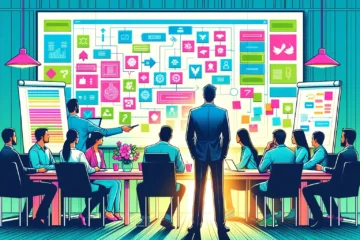The digital age brings innovations to every single industry. Information technologies integrate with every branch of human activity and change it completely. These days, we cannot separate IT from the other aspects of our lives: it is literally everywhere. And it is not only about entertainment. Web and mobile applications are upgraded with such cutting-edge technologies like the Internet of Things, Artificial Intelligence, Blockchain, etc.
A special role belongs to the healthcare application development. Some old-school specialists are still wondering how high-quality software may impact such vital processes. No doubt, the human factor is more important here than in any other industry. But at the same time, healthcare application can provide relevant up-to-date information, save both patients and doctors’ time, allow online consultations, etc. A survey provided by a healthcare company showed that people prefer an online meeting to a visit to a doctor. Of course, it depends on the particular situation and personal health but the point is that a health application makes a huge difference. Let us discover how to design and build health apps to make this world a bit better.
Healthcare Apps in Statistics and Numbers
The statistics on the healthcare industry provide us with tons of graphic data. The most impressive numbers are the following:
- In 2017 the number of health app downloads reached 3.7 billion, which is twice as many as in 2013;
- It is expected that by 2020 the global health software development market will reach $206 billion dollars of revenue.
Thus, we can say that every second inhabitant of the Earth has a health app installed on their smartphone. It opens wide horizons for the application development companies. At the same time, it causes a demand for high-quality solutions.
Healthcare institutions worldwide build partnership with IT companies in order to provide better services and win the attention of people. With the help of a simple mobile app, a healthcare provider can easily contact patients of staff. A smart device like a phone or a watch serves as the assistant in this process. The users can access their personal information within seconds; they feel more engaged and thus more confident and protected.
The app development for the healthcare industry is up and running. To join this rush and gain your own profit you need to build a solution that resonates with the users. The application’s one and only aim is to satisfy both the healthcare provider and the patient. No doubt, it is rather challenging. But having a clear vision of how things look like on the healthcare market right now, along with the comprehensive guide we provide, will help you succeed.
Healthcare Apps on the Market: Common Pitfalls and Needed Features
First of all, let us define the types of healthcare apps available on the modern market.
- Apps for personal health records
These applications help with diagnosis, allow checking symptoms, provide the patients with the results of laboratory tests, etc.
- Healthy lifestyle apps
These tools help to monitor your pregnancy or diet, allow tracking physical activity, etc.
- Apps for remote control
Lifescans, remote monitoring and viewing, and telehealth are the key purposes these apps can be used for.
- Apps for medical referencing
These are the software reference guides.
- Reminder apps
These are the simple tools for scheduling prescriptions or appointments.
Actually, the number of ways to implement software solutions into healthcare is almost unlimited. However, lots of medical apps do not cater to users’ needs and expectations, provide poor user experience and a limited number of features. So, what are the key mistakes one might make in a health app?
- Unclear interface and structure;
- Lack of useful data;
- Problems with data security.
In order to build a successful solution that is both compliant with the law and appeals to users, pay special attention to the above-mentioned factors. And take a look at the most important functionality users would like to experience when using your app:
- Fast and seamless access to medical records and test results as well as the possibility to download them;
- The access to doctor’s profile and schedule;
- Appointment scheduler and reminder;
- Prescription reminder;
- Weight, glucose, cholesterol tracker;
- Emergency call feature;
- Integration with Google Maps to find a way to the hospital;
- Notifications about news and events. etc.
Those are the basic features your potential users may need. Of course, it all depends on your app’s specifics and purpose but keep this list in mind to provide the best experience to your customers.
Designing and Developing a Healthcare App
After the brief introduction let us proceed with the development process itself.
Define the Problem
This is the very first task you need to solve before coding. Define the app’s essence and understand how and why the users will use it. The more clearly you see the answers to those questions, the better the result of the efforts will be.
Make sure that the software solution is the best way to solve the problem. Do research of competitors’ applications, analyze their strengths and weaknesses. It is also crucial to answer another simple question: will my app actually help? Many entrepreneurs worldwide want to jump on the trend train and invest in software development just because it is popular. A lot of software developers contribute to the industry just because it is a way to earn money and not because it brings obvious useful results for other people. The point is to make sure that you are going to start the development of an effective and powerful one-of-a-kind solution that solves problems, not emphasizes them. Start with something simple but useful and grow your idea like a small flower on your windowsill.
Get Acquainted with Your Audience
Consumer-driven development is the only way to profit. Let us clarify a very important thing here: your great app is just a bunch of lines of code if no one is using it. Many hospitals and healthcare institutions in the USA or Western European countries offer their patients custom mobile apps to improve the interaction and the processes. But as the experience shows, not every patient uses the suggested app. The application’s designers create an app they think is great. Unfortunately, in many cases, their opinion differs completely from the way things actually look like. The creators simply do not know their audience and thus fail to offer the best services.
The significant thing is to ask the patients and healthcare providers questions about what they actually need. If you have some doubts as to whether your app will meet the expectations, create a quick poll to make sure you do it right. Analyze the age and gender of the potential users and build a picture of their needs. Be attentive to their interests and preferences, include some gamification for the younger audience, and regularly check if your app is still relevant.
Design the App Carefully
Healthcare app design deserves to be highlighted in a separate chapter.
First of all, pay attention to the structure. If you are working on a large scalable solution, design it in modules. This approach provides 2 considerable advantages:
- If the need appears, it is easier for the developers to fix one single module;
- The user should not have to install the whole heavy app, but a single needed module. In case of need, the functionality can be upgraded with other extensions as well.
Now let us dive into user interface peculiarities. Always keep in mind that you deal with a sensitive target audience. Some of the users may be seniors, some may have disabilities. You should think ahead about all the people who will be using your app in the future and build a lovely user-friendly design along with the above-mentioned suitable functionality.
1. The Tricky Choice of the Color Scheme
Avoid vibrant, “crazy” colors: your app should not shock the user. Pick delicate and calming colors to make the users feel comforted when they open the app. Make them feel like they are visiting a reliable and competent doctor they have built a trustworthy relationship with. Colors play a great role when creating this type of atmosphere.
Most successful health apps are designed in cool tones. It allows the users to concentrate on the specific problem and the state of their health.
- White
White color implies purity and innocence; it calms the patient and positively influences the human brain. Different shades of white are suitable, pick one that you like.
- Blue
Peace and harmony are associated with the color blue. It may bring up the feeling of safety and healing. Medical staff worldwide tend to wear blue uniforms, which also proves the advantages of this color for your app.
- Green
Green is a color of youth and good luck. It is a color of nature and life, so it would be great to use shades of green (except neon of course) for your software solution.
Warm tones are less widely used for medical purposes. However, there are some applications that warm colors would be suitable for.
- Pink
This is the color of romance and childhood. It is often used for the design of web apps devoted to women’s or children’s health. But take note that if you are building a gender-neutral app this color will not be appropriate.
- Yellow
Yellow is the color of the stars and the sun; it is joyful and hopeful. However, bright shades of yellow may be a bit distracting, so it is recommended to only use elements of this color and combine it with more neutral colors. Since we are talking about personal sensitive information, the interface should not be too eye-catching.
The target audience means a lot as well. Children and youth tend to like bright and warm colors while older people prefer softer shades. You should also create conditions for the colorblind users. Add the color inversion option in order to make them feel comfortable.
2. Picking the Right Font
There are 2 key features you need to consider when choosing the font for your health app. They are minimalism and simplicity. The topic of healthcare is quite serious, so it is not appropriate to implement some super creative design skills to fonts and make them hard to recognize and read. Avoid small details and letters that look alike. Take into account the fact that your app will be used on different devices with different screen sizes. So use simple and easy-to-read fonts like Arial, Calibri or Sans Serif.
Take a look at some other recommendations for fonts:
- According to the best practices, it is good to use up to three fonts per platform;
- Android and iOS typography may differ, so make sure the chosen fonts look the same on both platforms;
- Use more recognizable fonts for the Call-to-Action button;
- Make the font size meet the users’ needs;
- Font color should contrast with the background.
A nice tip is to allow the users to customize the fonts according to their needs. In fact, it is not difficult to add such a panel to the pages of your app, but it improves user experience considerably.
3. Buttons, Icons, Images: Things to Be Aware of
Your application’s users may have specific needs, so try to make the buttons a bit bigger than usual. Set the active elements size to 48 pixels and more. Feature buttons with sound effects and simplify the usage for people with limited visual perception.
If we are talking about the healthcare industry, the icons and their meaning should be intuitive. Use only the most understandable and common icons and avoid the more complicated ones so as not to confuse the user.
When choosing the images for the healthcare app, give preference to the ones with better resolution. Add relevant pictures only, and avoid double entendres.
The Great Importance of Testing and Security
After your app is ready, test it carefully or hire a team that has expertise in QA and QC. It is crucial to provide the users with an impeccable, high-quality and bug-free solution. And testing is the only way to reveal imperfections before launching the app.
In modern society, the topic of data security is extremely important. Creating an app of such a great importance, you need to comply with the privacy laws in your country, limit the access to personal data and protect the users’ information. It is necessary to use special software plugins and extensions to improve data protection, and to cooperate with a qualified IT security specialist to avoid potential data breaches in the future.
Final Thoughts
Healthcare software development is a complicated task that consists of many important stages. It requires time, money and great focus to get a profitable and useful result. With the help of a competent team, this goal becomes achievable. Experienced software developers are able to get your idea to life. So let’s discuss your idea and make the world better together!

New Trends in Energy Trading and Risk Management Software











